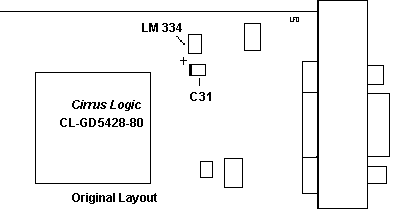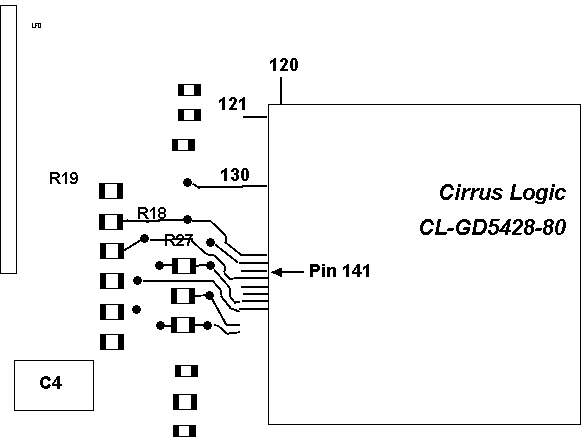|
IBM SVGA Adapter/A Driver
Disk
CL-542x Data
Book 1MB Short
SVGA
1MB Short SVGA 71G0650 Adapter ID is 917B IBM 1MB SVGA Adapter/A Long card... A long version of the short 71G0650 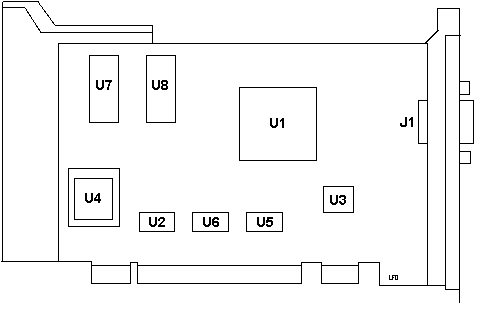
For the chipheads, the Tech Ref Annexes B-7 thru
B-10 have some
application notes. Data sheet is 4.8MB, Tech Ref is
2.7MB. Everybody needs to thank Elar Saar for guarding
these files until the
fullness of time. Peter says:
The CL chipset -by the way- is a
mask-programmed graphic
chip with integrated timing oscillator (no external
Xtal) and integrated
80MHz Ramdac. Very compact design. A similar chipset is
used on the Server
320/520 MCA/PCI sysboard. Here they used the
CL-GD5430-QC-D and 2 x Siemens
HYB514171BJ-70 (256K x 16 bit).
Flicker in 1MB SVGA I (god Emperor of Microchannel) and others have noticed that the 1MB SVGA flickers. Behold what devious minds can do- Dr. Jim
Peter:
If you check the connections from C31 you will find that the + marked end goes to the V+ input of U9 @ Pin 4, while the unmarked end is tied to +5VDC ... During operation the + end of C31 is at 3.09V ... and the - end at +5 ... with no dynamic offset of any sorts - I'd tested that with the scope. Shouldn't that be other way round ? There is a "+" marking silkscreened on the board, so the cap is mounted correctly regarding the silkscreen - electrically however it is reversed. And this circuit appears to me as the voltage reference for th CL5428-internal RAMDAC. (They pull down a definite current to give the RAMDAC a stable base voltage for the output drivers). What happens to a capacitor if you permanently run it at reversed polarity - even though the voltage is rather low ? (the cap is rated 20V) Given it develops some "leakage" and causes a parasitic current to +5V - parallel to the current flow through U9 ? That could explain the brightness changes in the video signal. I'm going to unsolder the C31 next to see how the card
behaves without
it or if it is intended as some sort of "choke up"
capacitor. And what
happens if I reverse the polarity.
Fixed 1MB SVGA 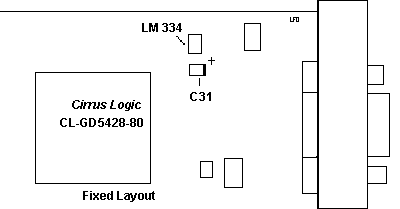
Dr. Jim > We need more empirical data ... ! I replaced the cap on the contemplation card a few minutes ago. This card was known to flicker, quite badly at times, and was pulled from this machine for that reason. I used a new 3u3/16v in the same form factor off a scrap PCB from work. Before I swapped the card, I laid down on the floor with my handheld DMM and confirmed your voltage readings before powering down the 500. Results; +5.15 VDC on the - terminal of the capacitor, +3.50 VDC on the + terminal. Backweirdness confirmed. The + end is 1.65V _more negative_ than the - terminal. Swapped the cards. My immediate impression was that the test card produces a much brighter and clearer screen image than the (identical) card I took out. This may be meaningless however, since I did not retest this card in the 500 before I changed the cap. I have not noticed any flicker so far. I will run it for a while and try to observe it as much as I can. This machine is my APRS server and runs 24/7, so it should be a good test. Type 4 'Y' at 180 MHz. David Beem
provides another data
point:
Fixed! I say a dramatic fix in that.
I can reproduce
the flickering at will by putting in the unpatched card;
It goes away with
the patched version, even for a lengthy time span. Who
would have knew?
Ratings for C31 Replacement I had a tag-team of David
Beem
and Dr. Jim
working this out.
> > Capacitance range 2.2uF to 4.7uF, voltage of at least 20v? Or would 16 to 25 work? Clone designs were using close to a 3.3uF
cap. For voltages
16v is sufficient & a commonly produced capacitor. I
would stay within
the range of 2.2 to 5 uF. It is remotely possible
that a cap that
is too large may draw excessive surge current on power
up and let some
of that delicate silicon smoke loose inside the chip.
2MB Short SVGA? Without the help of Jolt, I asked about pumping up the 1MB SVGA-
>Please point out the second pair of solder pads for additional memory on the short 1MB. Peter writes:
AdapterId 917b SVGA Adapter ROM Address
Japanese 1MB Short SVGA P/N 84G7001 Adapter ID is 917A 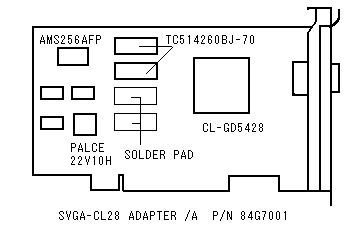
Tatsuo Sunagawa was the source for this. |
